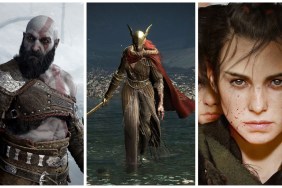Making up the time.
Kaim Argonar cannot remember his past, his face shrouded by a vacant expression, his long black hair blown mercilessly back by a wind thick with the fumes of war. He stands firmly upon the battlefield as a lieutenant of the Uhran army, and blankly stares at the lines and lines of Gohtzan infantry, armed with steel black armor and jagged blades, and flanked by heavy, lumbering mechanical tanks.
Soon, he will not need to remember, not his country or his title, not even his name. He will rush into the fray, effortlessly killing and dodging all who stand in his way, as his body tells him memories locked deep within his skin with each murderous swing of his sword. And after single-handedly dismantling a tank at least twenty times his size, he will witness an Armageddon. Burning meteors and running rivers of lava will descend from the sky and drench the battlefield in a molten sea of earthen red. But only a few minutes will pass before he rises from the ashes, his face shrouded by a vacant expression, for he is an immortal – a man of a thousand years who stands in a wind thick with the fumes of war but cannot remember why.
[image1]Sentimental, borderline verbose, borderline emo passages like the ones above are a hallmark of Lost Odyssey, a four-disc epic that harkens back to a time when multi-disc turn-based Japanese-style RPGs ruled the video game landscape. With the exception of grid-based RPGs, the current generation has not been kind to the “turn-based” genre, a style soon to be lost beneath the wave of more action-oriented RPGs. Well-respected franchises are either washing their brands of their slow and methodical nature, evolving into the likes of Final Fantasy XII, or being deluged by their more fast-paced brethren like Kingdom Hearts, Mass Effect, and Oblivion. As if a plea, Lost Odyssey tries to tell us in a single stroke not to forget the days of yore when pausing to think about your next move was pivotal, when opening up a strategy guide to collect every last accessory and Ultimate weapon was key, and when gorgeous cinematic cut-scenes were what made the story – and on those notes, it largely succeeds.
But first, a shamelessly envious note: I love hate Kaim. As an immortal with so-called “amnesia”, he can simply walk into a district with lots of pretty red lights and just say he forgot what color they were. Sure, the ladies aren’t going to buy it, but he’ll just remember feeling warm and fuzzy inside. Not only that, but during the course of his journey, he will encounter other immortals who have lost their memories too, including Ming, the thousand-year-old queen of the isolationist nation Numara, who is well-renowned for her beauty – her soft white skin, her silk dress, her exposed panties, her royal-sized boom-booms and bam-bams. You know, her ability to make sounds when she walks? Of course, Kaim can’t remember hearing anything, now can he?
Aside from that instance of regal exposure, every character has a well-rounded personality and a well-developed history. Better yet, with the almost mesmerizing graphics, even the immortals actually look like real people: Kaim may have a tall, dark, and handsome look, but it isn’t one that is overly stylized; Seth is as sassy and upfront as a pirate needs to be without being a buxom bombshell; and Sarah is a potent spellcaster with round glasses and a geeky hue. It fits perfectly as a reflection of the script, usually without too much overwrought intensity and complemented by a stunning orchestral score by Nobuo Uematsu of Final Fantasy fame. Many pivotal scenes, however, aren’t able to carry the weight of its pathos simply due to a lack of well-structured and consistent build-up, making the story feel more like abrupt one-hit wonders rather than a streamlined series of events.
Given the even-keeled approach to the story and the protagonists, the one-dimensional villain is incredibly disappointing. Within the first thirty minutes, it becomes clear just who the warmongering, armor-heavy, thick-eyebrowed, snake-mouthed (and don’t forget, evil) sorcerer bent on world domination, err…, is. And in case you don’t realize who that person is, you’re subjected to multiple scenes that show the villain doing some random evil-of-the-day. It’s like me telling you his name repeatedly to make sure you know who the bad guy is – Gongora, the evil Gongora, the manically laughing Gongora, he-creates-evil-experiments Gongora, because he’s-got-spare-time and there-aren’t-any-Hooters-nearby Gongora. And you continue your journey, hoping that some substance is brought to the character – perhaps some backstory or a reason for his madness – but you discover he’s as cliché as a baddie in Dragonball Z; that is, very, very baddie-bad-bad-baddie-bad.
[image2]Interspersed throughout the narrative are written short stories in a series called A Thousand Years of Dreams that details Kaim’s long life as an immortal. Watching Reading a dream is like clicking through an emotionally subtle Powerpoint presentation: Words spiral in and fade out while sound effects sift their way through each page to match each turn of mood. As far as short stories go, all of them are actually well-written, wrapping around the theme of the preciousness and fragility of mortal life in the eyes of an immortal, but then again, they’re extremely distracting. They hardly ever show up at a convenient time, and though they are skippable and can be watched whenever your party takes a rest at an inn, it’s hard to resist reading them. It’s like watching a spectacular movie with a person that offers you delicious apple pie in the kitchen every twenty minutes. You want to keep watching, but… it’s… apple… pie… .
By now, you’re probably sick of reading about the story, and well, if that’s the case, then you’ll also probably be sick of Lost Odyssey. Cut-scenes take up at least twenty percent of your playtime – a little more if you’re caught unprepared for a boss battle. Most save points are appropriately placed right before any potentially party-wiping event, but there are some placements that are strangely far away and out of place, enough so that you have to skip through the pre-boss-battle cut-scenes one more time.
Fortunately, regular battles are not very difficult, especially if you’re experienced with the JRPG genre. Heroes are on one side, enemies are on the other, you input commands – like attack, skill, spirit magic, white Cure Heal magic, and black Firaga Flarus magic – for each of your party members, and then you watch each side duke it out until the next round of commands or until one side wins. Enemies have monster types and elemental properties that your party can exploit. They can also inflict status effects. Yeah, it’s not all that exciting, but at least it’s simple.
The only substantial differences are an introduction of ring assembly and a guard condition gauge, which really don’t change too much. The majority of items, which can be purchased from shops and found littered about the environment in pots, plants, and even hanging fruit, can be converted into attack rings that enhance physical attacks. Some exploit the elemental or monster type weakness, some allow the attacker to absorb health and mana, and some increase the frequency of critical hits. How effective the rings are depends on how well you time an outer ring as it collapses over an inner ring. Since attack rings can double the damage dealt, it’s also useful that you can switch between several different rings (and accessories) during the course of a single battle.
[image3]The guard condition, on the other hand, protects members in the back row with a wall whose defense is made up of the HP of the members in the front row. It’s a simple system that focuses your attention on the health of every party member, but it usually doesn’t require any depth aside from putting attackers in front and spellcasters in the back. It’s just another restriction that makes characters unable to multitask effectively, and as a result, every one of them is usually left to perform a specialized set of actions like physical attacks or spell-casting and nothing else.
As such, most of the difficulty doesn’t come from surviving any one particular battle, but in maintaining the strength of your party along the long trek toward an end boss. Healing spells, particularly early on, recover but a small amount of HP for the MP it costs to cast them. Since immortal characters automatically re-raise themselves after a couple of turns, Phoenix Downs Angel Plumes aren’t heavily used and some boss battles can be won with sheer tenacity.
Any attempt at level grinding, which takes an excruciatingly long time if your party is at a higher level than your enemies, quickly turns into SP grinding with the purpose of having immortals learn special skills from their mortal companions as well as a bevy of accessories. Once learned, skills can be set in an immortal’s slot stock, which can be expanded via certain rare accessories and slot seeds found in nooks and crannies all over the world.
Suffice it to say, your five-member-max party will likely consist of as many immortals as possible, and if you’re a completionist, a lot of your time will be spent slaying beasts just to learn abilities from accessories – and finding those accessories in the first place – like Ribbon Angel Guard, which grants immunity to all status ailments. Nonetheless, the fact that immortals can only learn some skills from mortals is an effective way to say through gameplay that though mortals are not as strong as immortals in the (very, very) long run, mortals possess unique qualities that immortals would not have without them.
[image4]Extending Lost Odyssey’s 50-hour playtime are numerous side quests that, as a matter of tradition, become available right before the final encounter. Most of them are all about defeating an optional boss and receiving the usual ultimate weapon, spell, or accessory. One welcome surprise is that many of them require you explore the world map, a feature that has been unceremoniously stripped from even next-gen RPGs. Just the water effects along the ocean’s surface are enough of a reason to rummage about the world. Unfortunately, neither the side quests nor the exploration of the world map are truly opened until the final disc, but the treasures and the sheer number of side quests are worth the price of the wait.
As a last hoorah to the turn-based JPRG (though, I hope this certainly won’t be the last one of this magnitude), Lost Odyssey accomplishes what it sets out to do. Nothing that it does, apart from its high production values, are examples of how to do the genre complete justice, but for a first outing for Microsoft, it’s more than satisfactory. Though Lost Odyssey won’t change your mind about turn-based JRPGs, it fills the void of the genre with a well-paced and pleasing aesthetic, and a healthy dose of nostalgia.
-
Likable, everyday protagonists
-
Spectacular graphics
-
Sweeping soundtrack
-
Plenty of side quests
-
One-dimensional villian
-
Immortals trump mortals in combat
-
Simple but ordinary battle system
-
Royal panties Queen Ming?
-
Continue Playing vs. Apple Pie










